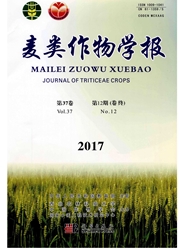

 中文摘要:
中文摘要:
为深入探讨水氮互作对冬小麦光合的影响机制,在温室盆栽条件下,以冬小麦品种陇育216为材料,分析了不同土壤水分和氮素条件下冬小麦叶片气体交换和叶绿素荧光参数的差异。结果表明,在水分胁迫(35%FWC)和正常水分供应(70%FWC)下,从9:00到 17:00,中氮(5 mmol·L-1)处理小麦叶片净光合速率(Pn)显著高于低氮(2 mmol·L-1)。与正常水分供应相比,水分胁迫均降低了Pn、气孔导度(Gs)和蒸腾速率(Tr)。增施氮肥可提高水分胁迫下的Gs、Tr和Rd,消除水分胁迫对Gs、Vc,max、Jmax、TPU和Fv/Fm的负效应,降低了qP和ETR。说明适度施氮可促进水分胁迫下气体交换、光能利用以及PSII的光化学反应和电子传递,从而提高冬小麦光合和对水分缺乏的适应能力。
 英文摘要:
英文摘要:
In order to elucidate the mechanisms of winter wheat in response to soil water and nitrogen availability, gas exchange and chlorophyll fluorescence of winter wheat were measured under different water availabilities and nitrogen supplies in a greenhouse pot experiment. Under both water treatments, the Pn under moderate nitrogen supply (5 mmol·L-1) was higher than that under low nitrogen supply (2 mmol·L-1) from 9:00 to 17:00, but high nitrogen supply (10 mmol·L-1) inhibited the Pn. Compared with those under 70%FWC, the Pn under 35%FWC was less with low, moderate and high nitrogen supply. Compared to those under 70%FWC, the Gs and Tr under 35%FWC was less, but nitrogen supply can lead to the increases in Gs and Tr. Under 35% FWC, the Rd was reduced and can be improved by moderate nitrogen supply. Under 35%FWC, moderate nitrogen supply can improve the Vc,max, Jmax and TPU as well as Fv/Fm. Water stress and low nitrogen supply both led to the increases in qP and ETR. In conclusion, water stress led to the reduction of net photosynthetic rate, but to the increase in qP and ETR. The photosynthetic capacity of winter wheat under water stress can be improved by moderate nitrogen supply through the increases in the Gs, Vc,max, Jmax, TPU and Fv/Fm.
 同期刊论文项目
同期刊论文项目
 同项目期刊论文
同项目期刊论文
 Water use efficiency by alfalfa: Mechanisms involving anti-oxidation and osmotic adjustment under dr
Water use efficiency by alfalfa: Mechanisms involving anti-oxidation and osmotic adjustment under dr Soil nitrogen, carbon and phosphorus after lucerne conversion to wheat or fallow in the Loess Platea
Soil nitrogen, carbon and phosphorus after lucerne conversion to wheat or fallow in the Loess Platea 期刊信息
期刊信息
